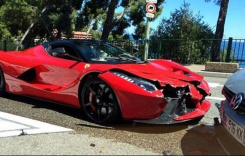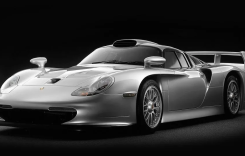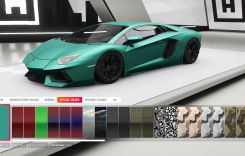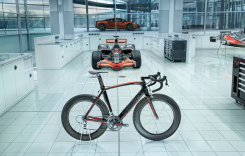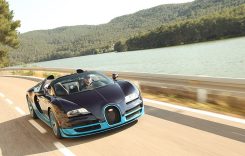As usual refinement is the name of the game for Honda in the 450 motocross class with its CRF450R ($8699 plus $310 destination charge). Big Red’s ’15 bike sees a multitude of tweaks highlighted by KYB’s second generation air fork, on-the-fly adjustable engine power modes, and subtle engine and braking hardware improvements.Despite being easy to ride in a variety of terrain, Honda’s 450 is often criticized for not being ‘fast’ enough. Honda answers with a unique solution, fitting a button on the right-hand side of the Renthal handlebar (971-bend) allowing the rider to switch between three engine power maps, on the fly, while riding.

Those seeking a hard-hitting powerband will appreciate the ‘aggressive’ setting. By pressing the button once, the sequence of the blue flashes imparts which mode the engine is currently operating. One flash is ‘standard’. Two flashes indicate the ’smooth’ setting (for use on slick surfaces or those that seek a less punchy spread of power), and three flashes the advanced setting.
(Top) The engine power mode switch lets riders choose between ‘standard’, ‘smooth’, and ‘aggressive’ power maps. (Center) The second generation air fork by KYB features independent high/low-speed compression (left leg) and rebound (right leg) circuits. This allows for precise damping adjustment. (Bottom) The rebound damping adjuster has been relocated from the bottom of the shock to the top next to the gas reservoir.
The system is easy to use and a difference can be felt in each mode, however the change isn’t as drastic as the plastic coupler set-up employed by the green and yellow brands. The ‘soft’ setting makes the powerband feel similar to the ’14 and ’13 machine with the ‘standard’ set-up giving added response/bark on the throttle. Overall it’s a worthwhile feature and one that will be appreciated by riders that encounter different terrain during the course of a moto or trail ride. Furthermore each of the three maps can be tweaked or replaced with your own custom map via Honda’s PGM-FI Tuning Kit ($489.95).
Complementing the electronics are a few mechanical updates including a heavier flywheel and new cylinder head in which the exhaust terminates from the right-hand side of the engine. The header is shorter but pumps combustion gasses through larger diameter mufflers. The transmission gears are fabricated from a more durable material and the piston has a new heat treatment for better wear resistance. Lastly, the clutch cable’s routing was tweaked for easier lever pull and to keep it further away from engine heat. Like before the engine is simple to light, requiring one or two strikes of the kickstarter.
On the chassis side the CRF gets KYB’s latest pneumatic spring fork. Each leg houses an air chamber (acts as the spring) and damping cartridge however compression (left) and rebound (right) circuits are split between fork legs (with both adjusters as well as the Schrader valves located atop each cap). Also of note is the added adjustability with high/low-speed adjustment on each side. At the back end the rebound adjustment screw has been relocated to the top of the shock body. Other updates include a larger front brake rotor and the fitment of Dunlop’s recently released Geomax MX52 intermediate-terrain knobs.
At 243 pounds full of fuel (claimed), the CRF feels light behind the handlebar. While its controls don’t offer the same-level of adjustment as some of the other brands – the relationship between the handlebar, seat, and foot pegs feels right and it’s an easy bike to get acclimated to.
Out on track the Honda continues to impress with its athletic chassis. Whether diving for
CRF450R Suspension Settings
Fork
Air Pressure: 35 psi
L/S Compression: 10 (Turns out)
H/S Compression: 11
L/S Rebound: 8
H/S Rebound: 7
Shock
Sag: 105mm
L/S Compression: 15
H/S Compression: 16
Rebound: 4
an inside rut or blasting around the outside of a fluffy berm the CRF steers in each situation with minimal effort and a fair degree of predictability. While we love the way the red bike steers, its chassis is more active and hyper-feeling through straightaways and when entering corners. Fortunately its suspension (especially the front) offers a greater range of finite adjustment—it just takes a little more time to set-up.
Braking performance, especially after a couple hours of engine run time, has always been a weak link. So the oversized front brake disc is a welcome change offering improved stopping power without having to pull so deeply on the brake lever.
(Top) The adjustable engine power mode switch is a welcome addition allowing riders to easily modify the character of the powerband based on terrain or preference. (Center) The Honda CRF450R boasts an athletic chassis that’s pin-point accurate and easy to put anywhere on track. (Bottom) Added tune-ability is one of the biggest features of the second generation KYB air fork. While it does take more set-up time it offers much more precise adjustment than the previous version.
If you love riding red but think that the 450 comes up short in the motor department then you’ll love the ’15 bike. With the combination of the engine mode switch and added tune-ability of the 2.0 KYB air fork the CRF offers a greater range of adjustment for all riders in all conditions.
Honda CRF450R Highs & Lows
Highs
- Push-button engine power mode selection
- Light and nimble handling
- Highly tune-able air fork
Lows
- Suspension requires more careful set-up
- Chassis can feel ‘hyper’ if not tuned properly
- Purchase price doesn’t include fork air pump

